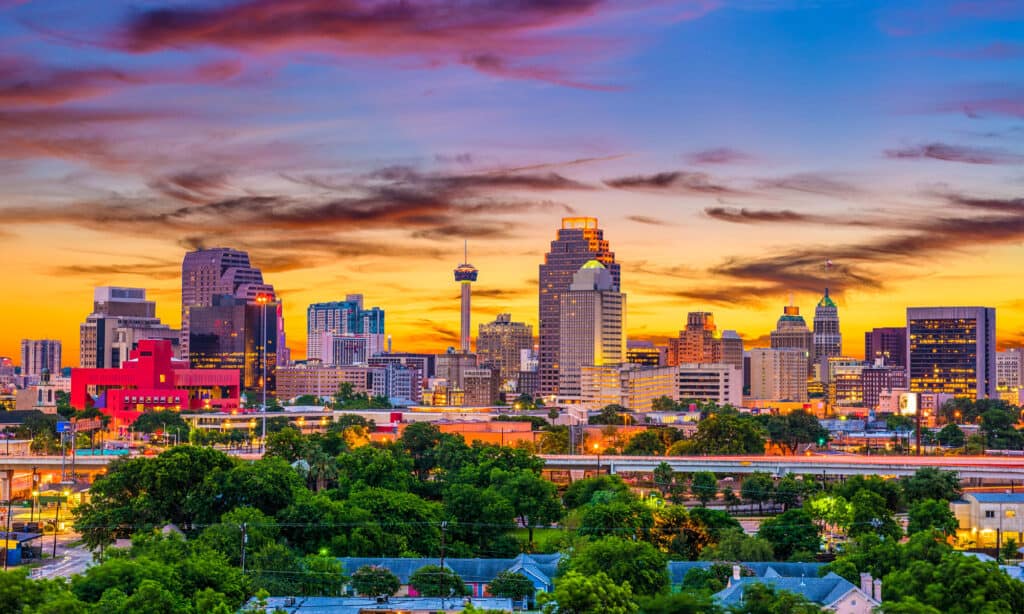While 2050 seems a long way off, it’s important to consider which cities will rise to prominence and which will be left behind. The most populated city in Texas ranks as the fourth most populous city in the nation, but it’s possible that another Texas city will surpass it. In addition, factors like education, infrastructure, health care, and resources can play a major role in population growth within a city. Discover Texas’s largest city and find out if it will keep its title in 2050.
What is the Largest City in Texas?

The city of Houston is the fourth most populous city in the United States, following Chicago, Illinois.
©Silvio Ligutti/Shutterstock.com
Houston, Texas is the largest city in the state with a population numbering 2.29 million people. Houston’s metropolitan area claims a population of 6.6 million. The city is the fourth most populous city in the United States, following Chicago, Illinois, whose metropolitan area has a population of 8.9 million.
History of Houston
The city of Houston has a long and fascinating history. The settlement of Harrisburg was first established in the area in 1826. However, Harrisburg was wiped out in 1836 by a Mexican general.
The town was revitalized and named after Sam Houston, who was the first president of Texas. The first Congress of the Republic of Texas moved their government to Houston in 1837, but the action was short lived. By 1839, the government left Houston. From that point on, Houston was no more than a port for cotton trade until the Civil War.
During the Civil War, Houston acted as the Confederacy’s Trans-Mississippi Department headquarters. The war contributed to the city’s popularity, and many began to establish neighborhoods within the area. Houston became a major hub for railways and for trade. After ports in Galveston were damaged due to a hurricane in 1900, Houston became the main port city in Texas once again.
The primary reason for Houston’s growth and popularity, though, came with the discovery of oil in the region. Though cotton and lumber had been Houston’s main industries, the oil industry took over, leading to rapid expansion. Other factors, such as World War II, advancements in space technology, and prosperity in energy production allowed Houston to gain prominence both in Texas and throughout the United States.
However, Houston’s successes did not come without challenges. Collapse of the oil industry, pollution, and flooding from frequent hurricanes resulted in major economic and infrastructure problems within the city. Nevertheless, Houston remains one of the most popular cities in the nation.
Present Day
Today, Houston, Texas is a diverse city whose primary focus is the oil and gas industry. However, technology, health care, aerospace research, and engineering have all become increasingly more popular. The city supports various modes of transportation and trade, educational opportunities, and entertainment. For instance, the Houston Astros major league baseball team and the Houston Ballet are two major institutions that make the city unique.
How Will Houston, Texas Change by 2050?
The population growth rate of Houston has been slowly but steadily declining in recent years. While 2020 reported a 2.02% increase in population from 2019, 2023 saw a 1.58% increase in population from 2022. Although Houston is still a growing city, it is growing at a much slower rate than previous years. Therefore, it’s possible that another, more rapidly growing city in Texas could surpass Houston by 2050.
Within the next 10 to 15 years, Houston’s rate of population growth is likely to decrease substantially. Projections for the year 2035 estimate that Houston’s population will reach 7.569 million people. From the year 2034 to 2035, the city will experience a 0.81% increase in population. When compared to the 2.02% increase in population of 2020, the difference is significant. In addition, statistics are not the only factor that influence population. A host of other factors can cause a population growth rate to drop rapidly. As the future is unpredictable, it’s tough to say whether Houston’s population growth will recover or drop further before 2050.
Population Growth Factors
Some factors that influence population growth include education, infrastructure, and resources. For instance, Houston scores below the national average in percent proficiency in fourth grade and eighth grade math and reading. Houston also records the highest congestion cost per consumer out of the main cities in Texas with regards to vehicle traffic. Houston ranks in the top 25 cities in the United States with the most polluted air, and the city is much more likely to experience flooding than most others.
These factors combined can influence those living in Houston and those considering moving to the city. If a family values excellent education in public schooling, they might be more likely to move to Austin, where scores are above the national average. If a commuter wants to avoid congestion on roadways, he might consider El Paso, Texas, which reports a significantly lower congestion cost per consumer than Houston. As a result, Houston’s population growth would decrease, meaning that it could lose its title as the most populous city in Texas.
Growth Rates of Cities in Texas
San Antonio

While San Antonio’s population growth rate is larger than that of Houston’s now, it is expected to decline more rapidly than Houston’s.
©iStock.com/Sean Pavone
Another populous city in Texas, San Antonio, has a metropolitan area with a population of 2.454 million. However, this city is experiencing the same population growth problem. Between 2019 and 2020, San Antonio saw a 2.25% population increase. As of 2023, though, the city recorded a 1.7% increase in population from 2022. While San Antonio’s population growth rate is larger than that of Houston’s now, it is expected to decline more rapidly than Houston’s.
In 2035, predictions show that San Antonio is likely to be inhabited by 2.777 million people. However, its population growth rate between 2034 and 2035 is expected to show a 0.80% increase, which is slightly lower than that of Houston’s expected 2035 rate. Thus, San Antonio’s more rapid decrease in population growth rate disqualifies it as a valid contestant for surpassing Houston in 2050.
Austin

The population growth rate for Austin in 2035 is expected to sit at 0.79%, which is lower than that of Houston’s and San Antonio’s.
©Roschetzky Photography/Shutterstock.com
Austin, Texas has reported a 2.39% increase in population between 2022 and 2023. Its metropolitan area population measures 2.228 million people. Austin’s population growth rate is also on the decline since 2020, though. From 2019 to 2020, the population of Austin, Texas increased by 3.43%.
For the year 2035, projections indicate that Austin will have a population of 2.56 million. However, its decline in population growth since 2018 means that it will not surpass Houston at any point in the next two decades or beyond. The population growth rate for Austin in 2035 is expected to sit at 0.79%, which is lower than that of Houston’s and San Antonio’s. Due to the drastic difference between Houston’s and Austin’s population currently, a decreased growth rate pulls Austin out of the running for the largest city in Texas by 2050.
Dallas

In 2035, Dallas is expected to have a population numbering 7.380 million people.
©f11photo/Shutterstock.com
Dallas, Texas has a metropolitan area with a population of 6.574 million. The population of Dallas increased by 1.33% between 2022 and 2023. Like San Antonio and Houston, though, Dallas’s population growth rate is decreasing. In 2020, Dallas experienced a 1.61% increase in population from 2019. Unlike San Antonio, Dallas’s population growth rate is decreasing at a slower rate than that of Houston’s.
In 2035, Dallas is expected to have a population numbering 7.380 million people with a population increase of 0.82% between 2034 and 2035. This means Dallas’s population will see a 0.01% greater increase than Houston’s population. According to this estimate, in 2035, Houston’s population will be greater than Dallas’s by 189,000 people.
What will the Largest City in Texas be in 2050?
Is the 0.01% greater increase in population growth enough for Dallas to surpass Houston in 2050? It all depends on who you ask. Assuming that the rate of population growth for Houston and Dallas will continue to decrease at a consistent rate, the statistics mentioned above suggest that Houston would just slightly surpass Dallas in population by 2050. However, the difference would be small.
On the other hand, some reports indicate that Houston would reach a metropolitan population of 10 million by 2050 in a moderate growth scenario. Simultaneously, Dallas could see a population between 13 and 16 million for 2050. Therefore, it’s difficult to determine which city will have a larger future population.
Up Next
- Discover the 10 Most Populated Cities in India
- The Flag of Texas: History, Meaning, and Symbolism
- The 11 Oldest Towns in Texas
The photo featured at the top of this post is © Silvio Ligutti/Shutterstock.com
FAQs (Frequently Asked Questions)
What is the most populous city in Texas?
The most populous city in Texas is Houston with a metropolitan area population of 6.6 million.
Will Houston still be the most populous city in Texas in 2050?
Houston could be the most populous city in the state in 2050. However, Dallas could surpass Houston by several million.
What factors play into population growth or decline?
Some factors that influence population include education, health care, infrastructure, and resources.
Thank you for reading! Have some feedback for us? Contact the AZ Animals editorial team.






